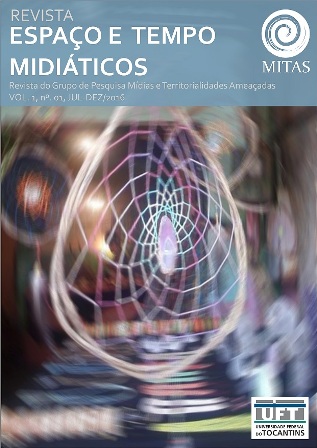NORMATIZATION AND USE OF THE TERRITORY IN THE PERSPECTIVE OF THE REMAINING COMMUNITIES OF QUILOMBOS: CASE STUDY OF THE COMMUNITY CAFUNDÓ, SALTO DE PIRAPORA-SP
DOI:
https://doi.org/10.20873/stmmta2016-3162Keywords:
uso do território; comunidades quilombolas; espaçoAbstract
The article deals with the question of the use (s) of the territory made by the remaining community of quilombo Cafundó, located in Salto de Pirapora-SP. Over the years – from the inheritance of land by the slave family, along with the manumission in the mid-nineteenth century to the present day – the community lands were gradually being invaded by neighboring farmers. With the expansion of the possibilities for the conquest of ethnic and territorial rights by rural black communities after the promulgation of the 1988 Federal Constitution, the struggle and resistance of the inhabitants of the Cafundó resulted in their recognition as quilombolas and in the demarcation of lands by the National Institute of Colonization and Agrarian Reform (INCRA), supported by Decree N° 4.887 / 2003. However, land use planning, carried out by the Community Association with the support of the Land Institute of the State of São Paulo (ITESP), faces challenges arising from the demarcation of the quilombo on particular areas (resulting from the land expropriation suffered by the quilombolas). Whose expropriation involved a lengthy and complex judicial process. In order to understand the organization of the area and the use of the territory in the local context, field research consisted of monitoring the activities of the Community Association, the work of the quilombola farmers, the main cultural events of the community and the work of INCRA and ITESP, responsible for the land regularization actions and technical assistance to the remnant quilombo communities. Thus, the research sought to analyze the planning, use and appropriation of the territory in the local context, taking into account the following territorial elements: productive activities, the work of the state organs that operate in the quilombos and the symbolic and identity forms of appropriation of the territory by quilombolas and “no quilombolas”. In this sense, space and territory were key concepts for the understanding of reality: space as an accumulation of materialities of past modes of production or different phases of the same mode of production; and the territory as a materialization of relations of power, source of natural resources, the basis of economic relations and constructed from symbolic-cultural references. Based on these theoretical-methodological premises, we have verified that the guarantee of the territorial rights of the quilombola communities depends on a more comprehensive set of relations, represented by the struggle and resistance of the community, by broader political-economic interests and by the State's action based in a normative system oriented to the (territory's) use.
References
ANDRADE, Tânia (et. al. [eds.]) Negros do Ribeira: reconhecimento étnico e conquista do território. São Paulo: Cadernos ITESP 3, Páginas & Letras, 2000, 2ª ed.
ANJOS, Rafael A. Sanzio dos. Território das comunidades remanescentes de antigos quilombos no Brasil: primeira configuração espacial. Brasília: Mapas Editora & Consultoria, 2005.
BRANDÃO, Carlos Rodrigues. Participar-pesquisar in BRANDÃO, C. R. (org.). Repensando a pesquisa participante. São Paulo, Brasiliense, 1999.
FIABANI, Adelmir. Mato, palhoça e pilão: o quilombo, da escravidão às comunidades remanescentes [1532-2004]. São Paulo: Expressão Popular, 2005.
FREITAS, André Vieira. Uma política de ordenamento territorial para o Brasil? In STEINBERGER, Marilia (org.). Território, Estado e políticas públicas espaciais. Brasília: Ler Editora, 2013.
GOMES, Maiara da Silva (et. al.). O potencial político da categoria ‘território usado’ in STEINBERGER, Marilia (org.). Território, Estado e políticas públicas espaciais. Brasília: Ler Editora, 2013.
GUANAES et. al. Quilombos e Usos Sustentáveis. In: DIEGUES, Antonio C. e VIANA, Virgílio M. Comunidades Tradicionais e Manejo dos Recursos Naturais da Mata Atlântica. São Paulo: Hucitec, 2004, 2ª Ed.
HAESBAERT, Rogério. O mito da Desterritorrialização: do “fim dos territórios à multiterritorialidade. Rio de Janeiro: Bertrand Brasil, 2012.
INICIATIVA VERDE. Plantando Águas: promoção da adequação ambiental de imóveis rurais no Estado de São Paulo, em sentido amplo e de forma participativa. São Paulo: Programa Petrobrás Ambiental, maio de 2013.
PILLA, M; ANDRADE, M. R. O; MARQUES, L. A. P. (orgs.). Fundação ITESP: sua história e realizações. Evolução das políticas agrária e fundiária no Estado de São Paulo. São Paulo: ITESP, 2013.
PRADO JR., Caio. A Formação do Brasil Contemporâneo. São Paulo: Editora Brasiliense, 1994.
PREFEITURA MUNICIPAL DE SALTO DE PIRAPORA. Plano Diretor Municipal (Lei Complementar nº 012 de 14 de dezembro de 2010).
PRESIDÊNCIA DA REPÚBLICA. Decreto 4.887 de 20 de novembro de 2003.
___________. Secretaria de Políticas de Promoção da Igualdade Racial (SEPPIR). Programa Brasil Quilombola. Relatório de Gestão 2012. Brasília, abril de 2013.
RAFFESTIN, Claude. Por uma geografia do poder. São Paulo: Ática, 1993.
SANTOS, M. Por uma Geografia Nova. São Paulo: HUCITEC, 1986.
___________. A Natureza do Espaço: Técnica e Tempo. Razão e Emoção. São Paulo: EDUSP, 2014.
SCHNEIDER, Sérgio. As atividades rurais não-agrícolas e as transformações do espaço rural: perspectivas recentes. Cuadernos de Desarollo Rural, Bogotá – Colômbia, v. 1, n. 44, p. 11-40, 2000.
___________. As novas formas sociais do trabalho no meio rural: a pluriatividade e as atividades rurais não-agrícolas. Revista Redes, Santa Cruz do Sul – RS, v. 9, n. 3, p. 75-109, 2005.
SILVA, Clayton Luiz. A divisão política do território brasileiro: os compartimentos quilombolas no Vale do Ribeira (SP). Tese de Doutorado. Campinas: Instituto de Geociências, Unicamp, 2010.
SILVA, Clayton Luiz; ISOLDI, Isabel. O espaço territorial como referência para a construção da cidadania: uma reflexão geográfica introdutória sobre o problema das demarcações de terras das populações “remanescentes”. In: Revista Eletrônica Ateliê Geográfico, Curitiba, Editora da UFPR, 2008, v. 3, n. 16, p. 73-79.
STEINBERGER, Marília. A inseparabilidade entre Estado, políticas públicas e território in STEINBERGER, Marilia (org.). Território, Estado e políticas públicas espaciais. Brasília: Ler Editora, 2013.
VOGT, Carlos (ET. AL.). A Comunidade Cafundó. Mafambura e Caxapura: na encruzilhada da identidade. Caderno de Estudos Linguísticos, IEL/Unicamp, n° 6, 1984, p. 111-128.
___________. Cafundó: a África no Brasil. São Paulo: Companhia das Letras, 1996.
Downloads
Published
How to Cite
Issue
Section
License
Os originais aceitos e publicados tornam-se propriedade da revista, sendo vedada sua reprodução total ou parcial, sem a devida autorização da Comissão Editorial, salvo para uso em estudo e pesquisa.



